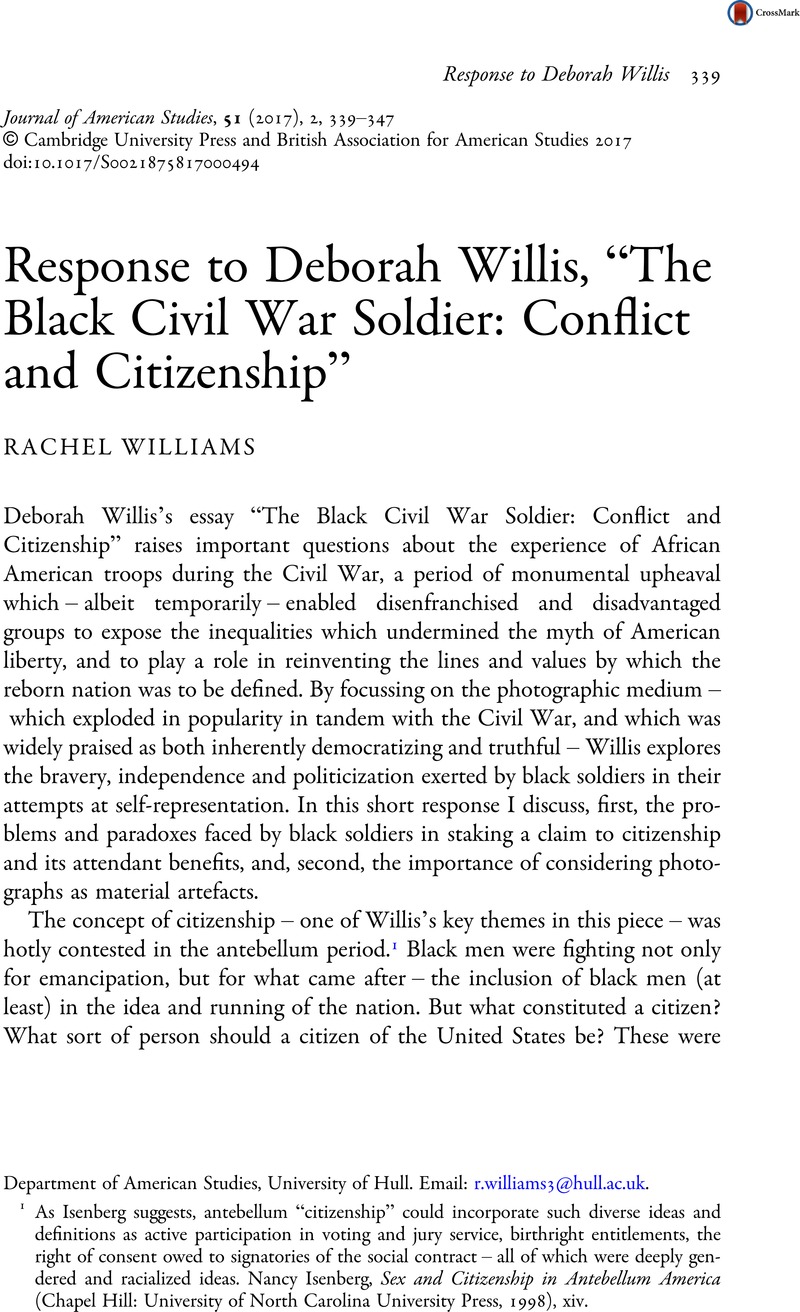No CrossRef data available.
Published online by Cambridge University Press: 08 May 2017

1 As Isenberg suggests, antebellum “citizenship” could incorporate such diverse ideas and definitions as active participation in voting and jury service, birthright entitlements, the right of consent owed to signatories of the social contract – all of which were deeply gendered and racialized ideas. Isenberg, Nancy, Sex and Citizenship in Antebellum America (Chapel Hill: University of North Carolina University Press, 1998), xivGoogle Scholar.
2 Nelson, Dana, National Manhood: Capitalist Citizenship and the Imagined Fraternity of White Men (Durham, NC: Duke University Press, 1998)CrossRefGoogle Scholar, demonstrates how citizenship and civic identity were overwhelmingly articulated – culturally, socially, politically and judicially – as the preserve of white men.
3 Gallman, J. Matthew, “Foreword,” in Coddington, Ronald S., African American Faces of the Civil War: An Album (Baltimore: Johns Hopkins University Press, 2012), xiiiGoogle Scholar.
4 Bederman, Gail, Manliness & Civilization: A Cultural History of Gender and Race in the United States, 1880–1917 (Chicago: The University of Chicago Press, 1996), 20–31 Google Scholar.
5 Even relatively positive stereotypes (such as the idea that African Americans were naturally courteous and selfless) proved a barrier to racial equality; as Fredrickson points out, many northern abolitionists persisted in viewing the African American “more as a symbol than as a person.” Fredrickson, George, The Black Image in the White Mind: The Debate on Afro-American Character and Destiny, 1817–1914 (New York: Harper Torchbooks, 1971), 109Google Scholar. One of the most striking features of black Civil War portrait photography is how it emphasizes the individuality of each specific subject.
6 Hatt, Michael, “‘Making a Man of Him’: Masculinity and the Black Body in Mid-Nineteenth Century American Sculpture,” Oxford Art Journal, 15, 1 (1992), 21–35 CrossRefGoogle Scholar, 21–22.
7 James O. Horton, “Freedom Yoke: Gender Conventions among Antebellum Free Blacks,” Feminist Studies, 12, 1 (Spring 1986), 51–76, 55. Horton points out that, in reality, economic inequality meant that very few free black families could survive solely on the income of the male head of household, meaning many free black women combined wage-earning and domestic labour.
8 This was not solely a problem which confronted African American troops; see Smith, Michael T., “The Beast Unleashed: Benjamin F. Butler and Conceptions of Masculinity in the Civil War North,” New England Quarterly, 79, 2 (June 2006), 248–76Google Scholar, for a discussion of the tension in northern culture between aggression and self-restraint, and how the Civil War complicated, challenged and ultimately changed prevailing models of northern masculinity.
9 Reidy, Joseph P., “The African American Struggle for Citizenship Rights in the Northern United States during the Civil War,” in Ural, Susannah J., ed., Civil War Citizens: Race, Ethnicity, and Identity in America's Bloodiest Conflict (New York: New York University Press, 2010), 213–36CrossRefGoogle Scholar, 224–25.
10 Hatt, “‘Making a Man of Him’,” 24–25.
11 Higginson, Thomas Wentworth, “Leaves from an Officer's Journal,” Atlantic Monthly, January 1865, cited in Higginson, Army Life in a Black Regiment (Boston: Fields, Osgood, & Co., 1870), 10Google Scholar.
12 Kerr-Ritchie, Jeffrey R., “Rehearsal for War: Black Militias in the Atlantic World,” Slavery & Abolition, 26, 1 (2005), 1–34 CrossRefGoogle Scholar, 20. Kerr-Ritchie demonstrates that this link between self-defence and rights of citizenship was established within northern black communities decades before the Civil War, and paved the way for the formation of the USCT.
13 Trachtenberg, Alan, for instance, in “On Reading Civil War Photographs,” Representations, 9 (Winter 1985), 1–32 CrossRefGoogle Scholar, considers the implications of curation and exhibition for the meaning and significance of photographs .
14 Mitchell, Reid, The Vacant Chair: The Northern Soldier Leaves Home (Oxford: Oxford University Press, 1993), 20–29 Google Scholar; Richard, Patricia, Busy Hands: Images of the Family in the Northern Civil War Effort (New York: Fordham University Press, 2003), 119–25Google Scholar.
15 Foner claims that over 90% of the southern adult black population was illiterate in 1860. Foner, Eric, Reconstruction: America's Unfinished Revolution, 1863–1877 (New York: Harper and Row, 1988), 96Google Scholar.
16 See also Davis, Keith F., “‘A Terrible Distinctness’: Photography of the Civil War Era,” in Sandweiss, Martha A., ed., Photography in Nineteenth-Century America (Fort Worth: Amon Carter Museum, 1991), 131–79Google Scholar, 143.
17 Richard has explored how the smell and feel of letters helped to transmute abstract emotions – such as love – into tangible objects. Richard, Busy Hands, 109.
18 Rosenheim, Jeff, Photography and the American Civil War (New York: Metropolitan Museum of Art, 2013), 123Google Scholar.
19 Gallman, “Foreword,” xxii.